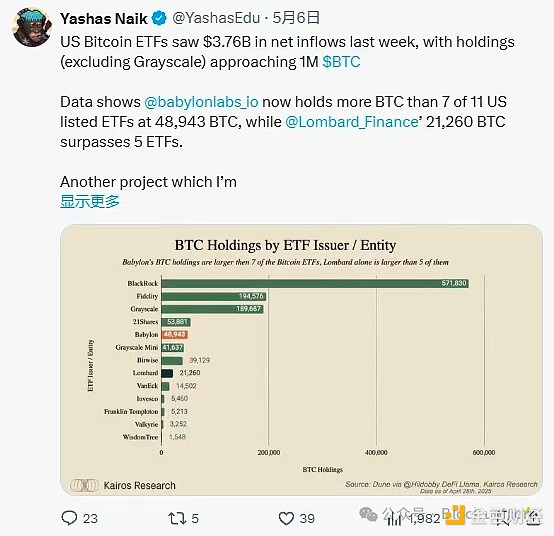Compiled by: Block unicorn
Foreword
Decentralized finance (DeFi) on Bitcoin is no longer just theory. Despite some setbacks, momentum is building around unlocking Bitcoin's potential beyond digital gold.
But let's be honest: no one is really paying attention. And understandably so. Because until recently, things have been a bit confusing.
While Ethereum built a massive DeFi economy, Bitcoin sat on the sidelines, with over $1.5 trillion in liquidity locked in cold wallets. The absence of DeFi smart contracts, the lack of a decentralized wrapper/bridge (wBTC), and Bitcoin's identity as digital gold have limited the development of an ecosystem around the orange currency. But things are changing.
With a wave of new protocols launching on and around Bitcoin, we're seeing the foundations of a truly BTC-native DeFi stack. Projects like Babylon, Lombard, SatLayer, and Solv Protocol are leading the way in terms of technology and total locked value (TVL), each solving a different part of the DeFi Lego.
Babylon: Bitcoin’s Staking Layer
Babylon can be likened to Ethereum’s Beacon Chain, but designed specifically for Bitcoin. It is a native Bitcoin staking protocol with over $5 billion in TVL, the first of its kind.
What’s special about Babylon is that it allows users to stake BTC directly on the Bitcoin mainnet, without a bridge or wrapper. The coins remain in place, stored in a non-custodial manner.
But Babylon is not just about staking for staking’s sake. Its main innovation is to extend the security of Bitcoin to other blockchains, whether they are EVM chains, Rollups, or application chains.
Bitcoin holders can now help secure the network by locking up their coins and earn rewards from the chains they secure.

Lombard: Liquid Staking for Bitcoin
It’s the Lido of Bitcoin. Babylon does staking; Lombard makes it composable.
As a result, Lombard, which has $1.9 billion of Bitcoin-related TVL, is built on Babylon. It allows users to stake BTC through Babylon and receive LBTC, a liquid staking token that represents the staked position.
In fact, as we said before, BTC staked through Babylon remains locked on the BTC network. Therefore, they are “useless” without the consensus mechanism to validate other networks. They cannot be used in DeFi. This is where Lombard comes in. Now, users can get liquidity to stake BTC (LBTC) and start trading, lending, mining, and all the other similar things.
Lombard earns yield by delegating BTC to Babylon validators, who in turn secure external networks and earn rewards as mentioned earlier. These rewards are shared with LBTC holders. In simple terms, the more chains Babylon validates, the higher the yield for stakers.
Lombard is active in multiple ecosystems such as Sonic, Sui, and Base, and has partnered with protocols such as Aave, Pendle, Ether.Fi, and Corn, demonstrating its composability. It also played a major role in the Boyco Berachain liquidity event, helping to kickstart early TVL.
SatLayer: Bitcoin's EigenLayer
As the title suggests, SatLayer can be imagined as an Eigen Layer built on top of Babylon.
Although its TVL is the smallest on the list at only $340 million, it introduces a new re-staking model. While Babylon locks BTC to secure external networks at the consensus layer, SatLayer allows users to re-stake LBTC to secure the application layer.
This opens the door to a market for yields directly from protected applications, for example, an oracle paying re-stakers to ensure data integrity, or a Rollup paying re-stakers to ensure transaction validity, or a bridge payment to avoid slashing or fraud.
SatLayer supports re-staking on the EVM and Sui networks.
See the full picture now?
Babylon as the base layer provides consensus for the network;
Lombard as the liquidity stake, unlocking the locked Babylon BTC;
SatLayer provides re-staking and provides economic security for the application layer.
Are the similarities with Ethereum, Lido, and Eigen Layer starting to emerge?
However, it is important to note that both Lombard and SatLayer currently depend on Babylon, but not vice versa.
SatLayer does not necessarily rely on Lombard, although it is currently the only solution it leverages given its decentralized nature.
Solv Protocol: BTC Reserve and DeFi Vault
The Solv Protocol, which has a TVL of $524.27 million in the BTC ecosystem, takes a different approach.
Similar to Lombard, it provides liquidity staking for BTC, but does not rely on Babylon and focuses on building its own Bitcoin reserve strategy and other DeFi products.
In effect, the SolvBTC token is a liquid representation of its BTC reserve strategy, with users depositing a wrapped version of BTC, which Solv then converts mostly into native BTC through institutional channels and stores through centralized custody.
While Solv does not rely on Babylon, it benefits from Babylon-related assets such as LBTC. In turn, it offers greater composability thanks to its DeFI vault.
Conclusion
DeFi on Bitcoin is no longer just a pipe dream. With new protocols emerging and liquidity improving, we may be witnessing a new era of decentralized yield on Bitcoin.
It’s no longer just about wrapping BTC on Ethereum, it’s about unlocking native BTC DeFi.
As more projects like Botanix launch EVM-compatible Bitcoin blockchains, the composability and potential value of these layers may take off. Billions of idle BTC may soon become active collateral, helping to validate the network, secure applications, and earn real returns.
Institutional investors are flocking to Bitcoin, and they like the yield.
 Alex
Alex
 Alex
Alex Miyuki
Miyuki Weiliang
Weiliang Alex
Alex Miyuki
Miyuki Alex
Alex Miyuki
Miyuki Weiliang
Weiliang Alex
Alex Catherine
Catherine